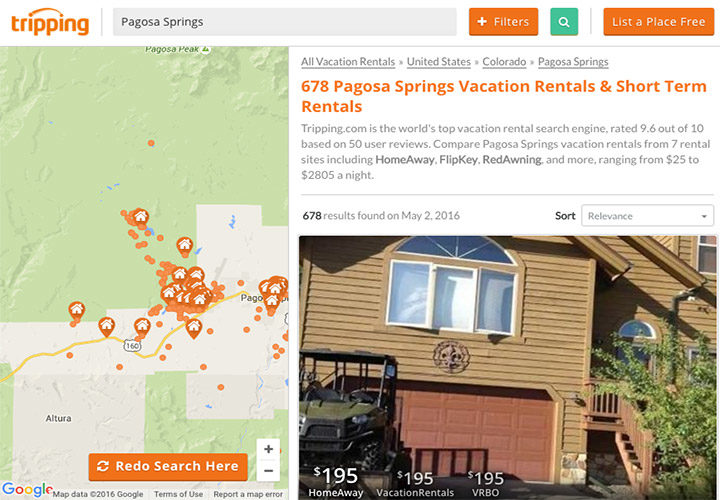Going on five years ago — in the summer of 2016 — I wrote an editorial series about a growing problem in Pagosa Springs. I thought it would be fun to share that article again, in 2021, and help us get a sense of how far we have come. The article was titled, “EDITORIAL: ADUs, STRs, and the Pagosa Housing Crisis, Part Five.”
The three of us — members of a subcommittee exploring how local government regulations help or hinder the creation of affordable housing — met at a downtown restaurant in the late afternoon, to work on the development of our report. We’ll be sharing our findings with the Archuleta County Housing Workgroup, which will in turn be generating a report for the Archuleta Board of County Commissioners and the Pagosa Springs Town Council — suggesting ways that government can be part of the solution to our housing crisis.
The restaurant owner stopped by our table to encourage us to plow ahead. He mentioned that at least a couple of his employees have no housing; they are camping in the national forest.
“That works okay in the summertime. Not so well in the winter,” he noted.
Can our local governments — who have obvious difficulties simply maintaining our streets and roads — actively support the creation of more small, affordable homes in Archuleta County… without excessively diverting taxpayer resources from other needs — like, for example, the maintenance of streets and roads?
We’re working on the assumption of a ‘Yes’ answer.
Thus far in this article series, we’ve been looking at ways to increase density within Pagosa’s historic downtown. But a simple increase in density does not guarantee that any of that increase will be affordable — to Pagosa’s working class, or to the growing segment of our community who are over the age of 65. Another piece of the puzzle, and very much a part of the current conversation, is the popularity of STRs. Short Term Rentals. Vacation Rentals By Owner. VRBOs.
Prior to the arrival of STR websites like AirBNB.com and VRBO.com, it was difficult for private vacation rentals to compete with our local motels, in terms of attracting the tourist customers who flock to Pagosa Springs during the summer months, and, in lesser numbers, during the ski season. But the Internet has changed the face of many industries, and as we’ve reported in a previous Daily Post article series, a remarkable number of Pagosa homes have recently become Short Term Rentals. As we can infer from the Tripping.com website…
… there might indeed be as many as “678 Vacation Rentals & Short Term Rentals” available this summer in Archuleta County. To put that number in perspective, we can refer to a January 2016 housing study published by researcher Donna Graves for the Region 9 Economic Development District.
Analysis of Archuleta County Assessors’ data found 8,239 [housing] units on 7,990 residential parcels in 2015. The majority (75%) of inventory is single-family residences. Multi-family units account for about 12% of the housing stock; these include duplexes, triplexes, condominiums and large apartment complexes. Manufactured (3%) and mobile homes (6%) are also common housing types.
The report (which you can download here) does not mention tents in the national forest.
The recent government conversations I’ve heard (and participated in,) concerning the growth of the STR market, center on a couple of crucial questions: Are housing units that were formerly “Long Term Rentals” now being converted into “Short Term Rentals?” And is this trend contributing to the housing crisis that is now requiring waitresses to live in out in the forest?
We have only anecdotal evidence to apply to these questions. But a fear often expressed is that regulations allowing increased density — anywhere — will simply lead to more cozy STRs being built, and might actually make the housing problem worse.
To try and get a handle on the above issues, we might note that Ms. Graves’ 2016 report focused largely on the very important second-home market in Archuleta County.
In 2015 an estimated 41% of residential properties were owned by people whose primary residence is outside of the county — Second Homeowners (up from 38% in 2006). What are these part-time residents doing with their properties now, and what do they intend to do with them in the future? How will the use of their properties impact planning for schools, medical services, public safety, recreation and other amenities?
Good questions. Let’s look at those numbers for a moment. We have about 8,200 housing units in Archuleta County. About 41 percent of them — about 3,360 housing units — are owned by people “whose primary residence is outside the county.”
There could be a couple of reasons why a person doesn’t live in Archuleta County but owns a “housing unit” here. The housing unit could be a second home, used by my family for a few weeks or months every year — or I could be a landlord, and the housing unit could be a rental unit that generates income for me.
The two situations are not the same. If I live in, say, Phoenix, and own a second home that I use for family vacations for a few weeks of the year — I will never want to rent my housing unit on a long term basis, because then I would have to evict my renter every time I want to use my own unit. I might, on the other hand, find it very attractive to offer my house on a Short Term Rental basis — whenever I am not using it myself.
But if I’m a landlord living in Phoenix and renting out a housing unit in Pagosa Springs, I might find it very inconvenient to try an operate a Short Term Rental operation, with new tenants moving in and out of my unit every few days, leaving who knows what kind of a mess behind. As a landlord, I might very well find it more appealing to rent out my housing unit to a permanent, long-term tenant.
Ms. Graves mailed out a survey to 2,822 “Second Homeowners” and back got responses from 1,133 of them. A sizable number of the respondents did not want to talk about whether they were renting out their properties as STRs. From the report:
5) Most (57%) of respondents currently use their properties as a vacation home for owner, friends and family use; 31% are used only by the owners, 12% are part-time rentals, and 11% are full-time rentals.
6) Eighty-five percent of respondents do not use their properties as short-term rentals, 11% advertise using a property manager, and 8% use internet sites. Others used “word of mouth” to advertise. Quite a few people (257) did not answer this question, the highest refusal rate of any question in the survey.
About 3,360 housing units in Archuleta County are owned by non-residents, we estimate. If 12 percent of those are “part-time rentals” that would total 403 units. And if we compare that number to the number advertised on the Tripping.com website — “678 Vacation Rentals & Short Term Rentals” — we might get a better feel for the STR problem, as it relates to affordable rental housing.
Has anything changed, in the past five years? Or has the problem only gotten worse?


